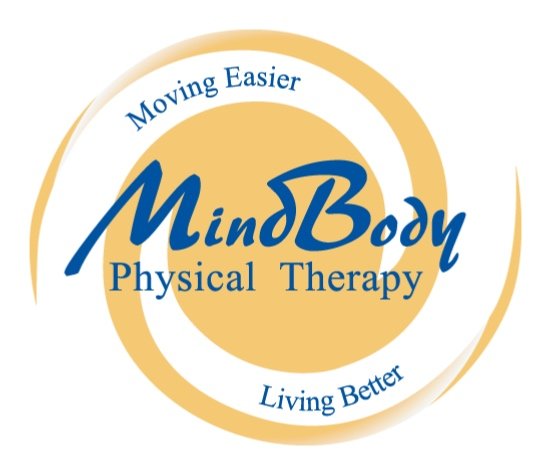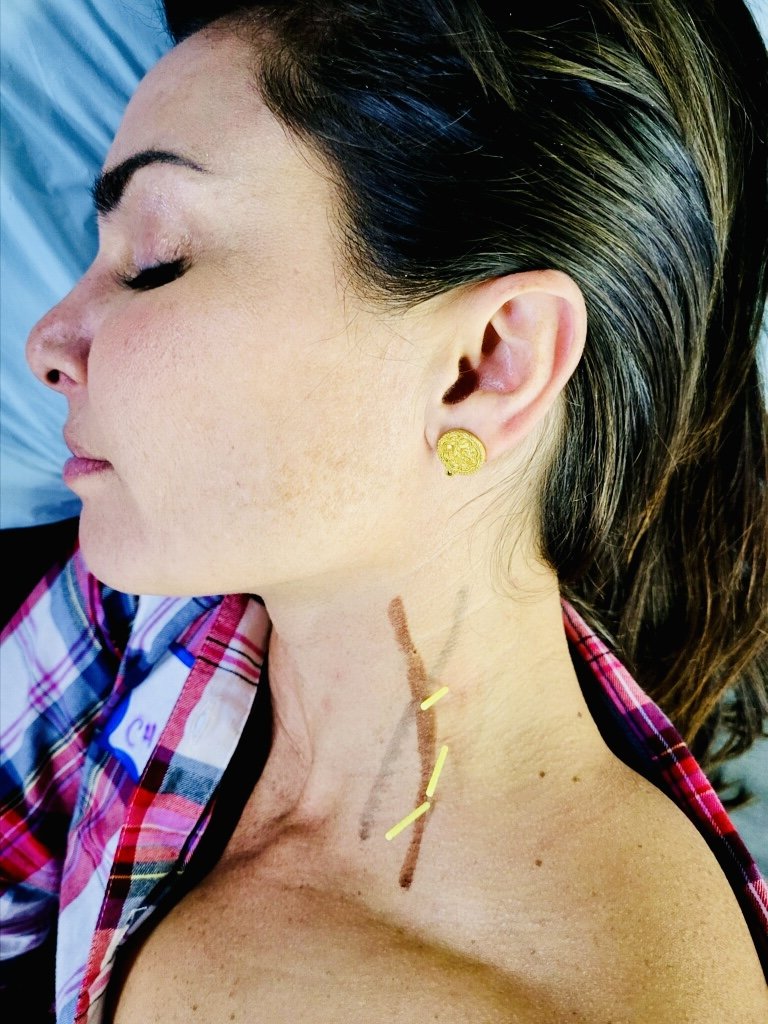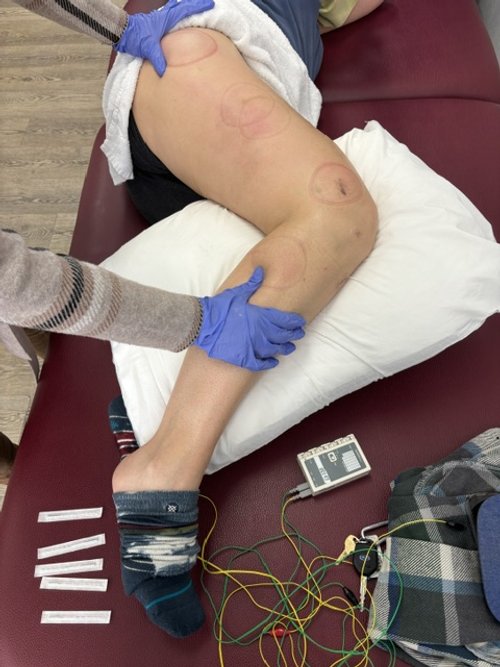
Dry Needling
What is dry needling?
Dry needling is a technique that physical therapists and other trained healthcare providers use to treat musculoskeletal pain and movement issues. It’s almost always used as part of a larger pain management plan that could include exercise, stretching, massage and other techniques. During this treatment, a provider inserts thin, sharp needles through your skin to treat underlying myofascial trigger points.
In the word “myofascial,” “myo” means “muscle.” Fascia is the thin, white connective tissue wrapped around your muscles.
Trigger points are knotted, tender areas that develop in your muscles. These trigger points are highly sensitive and can be painful when touched. Sometimes, a trigger point may be near the location of your pain. But they’re also often the cause of referred pain. Referred pain is pain that affects another part of your body.
Physical therapists use needles to alleviate your trigger points. When dry needling is applied to your muscles and tissues, it can decrease tightness, increase blood flow and reduce local and referred pain. Providers use solid needles that don’t contain any kind of medication. This is why the technique is called “dry.” Nothing is injected into your body. Trigger point injections are different. They contain medicine and are performed by a physician.
Other names for dry needling are trigger point dry needling and intramuscular stimulation.
How does dry needling work?
When your muscle is overused, it goes into an energy crisis where the muscle fibers aren’t getting an adequate blood supply. When they don’t get the normal blood supply, they don’t get the oxygen and nutrients that allow your muscle to go back to its normal resting state.
When this happens, the tissue near your trigger point becomes more acidic. Your nerves are sensitized, which makes the area sore and painful.
Stimulating a trigger point with a needle helps draw normal blood supply back to flush out the area and release tension. The prick sensation can also fire off nerve fibers that stimulate your brain to release endorphins, your body’s homemade pain medication.
Once your therapist locates a trigger point, they’ll insert a needle through your skin directly into it. They might move the needle around a little to try to get what’s called a local twitch response — a quick spasm of your muscle. This reaction can be a good sign that your muscle is reacting.
Some people feel improvement in their pain and mobility almost immediately after a dry needling session. For others, it takes more than one session.
Does dry needling hurt?
Trigger points are usually painful to the touch. So, before the needling, you may experience some pain while your provider is locating the trigger point.
You may also feel discomfort during the needling. Sometimes, people don’t feel the needle going in because it’s so small, but other times, people will feel a prick. When the needle is in the trigger point, it can be painful and cause a twitch response. Afterward, you may feel tightness or soreness near the insertion site, but it’s important to keep moving and stretching.
What does dry needling do?
Dry needling may help relieve pain and increase your range of motion. Conditions that dry needling may treat include:
Joint issues.
Disk issues.
Jaw and mouth problems, such as temporomandibular joint (TMJ) disorders.
Repetitive motion disorders, such as carpal tunnel syndrome.
Spinal issues.
Night cramps.
Postherpetic neuralgia, a complication of shingles.
Who shouldn’t get dry needling treatments?
There are certain groups of people who shouldn’t receive dry needling. Providers don’t recommend the procedure for children under the age of 12 because it can be painful. You and your child will both need to provide consent, and you should consider other less invasive options first. Other groups who should consult with their physician before receiving dry needling include people who:
Are pregnant.
Aren’t able to understand the treatment.
Are very afraid of needles (trypanophobia).
Have compromised immune systems.
Have just had surgery.
Are on blood thinners.
Procedure Details
What happens before a dry needling treatment?
Before any dry needling treatment, your provider will go over your medical history and perform a physical exam. They need to determine if dry needling is right for you. If they think you’re a candidate, they’ll explain how the treatment works and answer any questions you may have.
On the day of your treatment, you should dress comfortably in loose clothing. Wear something that allows your provider to easily access the treatment area. Otherwise, your provider will give you a gown or covering.
A provider will take you to a private exam room or a curtained-off section of a larger room. You’ll adjust your clothing as necessary, and they’ll place you in the correct position for your treatment.
What happens during a dry needling treatment?
First, your provider will sterilize the treatment area and prepare the needle. The needles are always single-use, sterile and disposable. Then, they’ll use one hand or their fingers to feel (palpate) the area to locate the trigger point. With their other hand, they’ll place the needle — surrounded by a plastic guide tube — over the area. The guide tube helps your provider accurately tap the needle into place while working with one hand.
Your provider will gently tap the needle into the top layer of your skin (epidermis) and discard the guide tube. The technique your provider uses may vary. Common dry-needling techniques include:
Superficial: Your provider will insert the needle 5 to 10 millimeters into the bottom layer of your skin (subcutaneous tissue) above the trigger point.
Deep: Your provider will insert the needle beyond the subcutaneous tissue deep into your muscle to penetrate the trigger point.
Depending on the technique, your provider may leave the needle in place for as short as two seconds to as long as 20 minutes. They may also use the pistoning technique. Also called the in-and-out technique, this method involves your provider quickly moving the needle up and down through the tissue.
Your provider may only use one to two needles during your first treatment. Once they see your response to the method, your provider may start using more needles. It depends on your condition. For instance, they may use up to 10 to 15 needles along your spine for a back treatment.
During the treatment, you may feel muscle soreness or twitching. These sensations are normal and a sign that your muscles are responding to the treatment.
What happens after a dry needling procedure?
After your dry needling treatment, your provider will remove the needle and examine your skin for any reactions. They’ll dispose of the needle in a medical sharps container.
Your provider will then have you get up slowly. If you’re experiencing any dizziness, they’ll have you sit down and rest before leaving the office.
After your treatment, make sure to drink plenty of water to stay hydrated. You may experience increased muscle soreness after the treatment but it’s important to keep moving. This is normal and may last for 24 to 36 hours. You could see some bruising near the treated area. This bruising may last for up to a week.
Risks / Benefits
What are the benefits of dry needling?
As part of your overall treatment plan, dry needling has many benefits. The procedure is inexpensive and generally considered safe. It carries a low risk of complications if performed by a trained provider.
Research shows dry needling can release your trigger points, which may help relieve your muscle pain and stiffness. Releasing your trigger points may also increase your flexibility and improve your range of motion.
What are the potential side effects of dry needling?
The most common side effect of dry needling is soreness during and after treatment.
Other side effects are typically minor. They may include:
There’s also a risk of infection. It’s important to confirm your provider has received proper training.
Serious side effects are extremely rare. However, if you experience bleeding from the insertion site, apply firm pressure and contact your provider or physician. If shortness of breath occurs, contact your provider or physician or call 911 immediately. If the needling was performed in your thoracic area, it could cause a collapsed lung (pneumothorax). This is extremely rare but requires a chest X-ray and further care.




